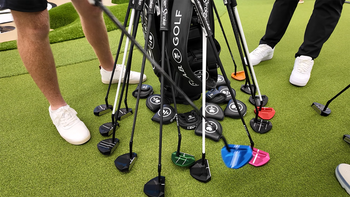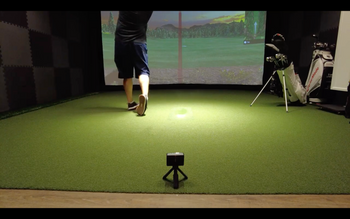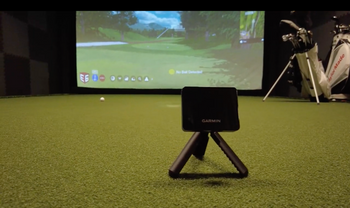You know those GPS rangefinders that are taking over golf courses? They're packed with wild features now. Let's figure out which ones actually matter for your game. When choosing between devices, it’s important to consider what will enhance your playing experience the most. A rangefinder vs golf watch comparison can reveal the strengths and weaknesses of each option, helping you determine whether precise distance measurements or a multifunctional wristwatch suits your style better. Ultimately, the right choice could significantly impact your performance on the course.
I gotta tell you, rangefinder tech just exploded out of nowhere.
Up until recently, I thought we'd hit the ceiling with these things. You'd walk into any golf shop and they all looked the same - point, click, get your distance. Every brand was basically selling the same gadget with a different logo slapped on it.
Boy, was I wrong. The latest crop of rangefinders makes the old ones look like flip phones. We're talking about smart rangefinders now - devices that combine GPS mapping with traditional laser accuracy. These things are getting so advanced, they're practically caddies that fit in your pocket.
Check this out - you can get rangefinders that show you the entire hole layout while you're shooting distances. Some even factor in elevation changes and tell you exactly which club to pull. It's not just cool tech for tech's sake either. This stuff can legitimately drop strokes off your round.
I've spent serious time testing the top five smart GPS rangefinders out there. We're talking weeks on the course with each one, checking them in different conditions and seeing what works versus what's just marketing fluff.
Here's what I'm gonna break down for you: the good stuff each one does well, where they fall short, how the features stack up against each other, and what you're looking at price-wise. When we're done, you'll know exactly which one fits your game - or if you should stick with your current setup.
Just so you know, I haven't gotten my hands on that new LINK tech from Foresight and Bushnell yet, or FlightScope's i4 that's coming out. Those bad boys supposedly give you the same data as a launch monitor - ball speed, spin, the works - right there in your rangefinder. They'll even suggest which club to hit based on your actual distances. Saw them at the PGA Show and they looked legit. Once I test them properly, I'll let you know if they're worth the hype.
Table of Contents
What Makes a GPS Rangefinder “Smart”?
Traditional rangefinders keep it simple - you point, click, and get your yardage. That's it. Nothing fancy, just the distance to whatever you're aiming at.
Smart rangefinders? They're playing a whole different game. These bad boys pack GPS technology that'll tell you way more than just the pin distance. You're getting front, center, and back of the green measurements, plus where all those water hazards and bunkers are hiding. Some even show you the entire hole layout - pretty sweet when you're playing a new course.
Now here's where it gets interesting. Every manufacturer does their own thing with displaying all this info. You might get everything right on the rangefinder's screen, or maybe it connects to your phone or golf watch. It's kinda like choosing between different golf apps - what works great for your buddy might drive you nuts.
Let me be straight with you though. These high-tech rangefinders aren't everyone's cup of beer. Some folks love having all that data at their fingertips, while others think it's information overload. If you're the type who just wants a quick number to the flag and nothing else, you might feel like you're paying for features you'll never touch.
The real question is whether you actually need all those bells and whistles. For some golfers, knowing exact hazard distances and having detailed green info shaves strokes off their game. Others? They just end up spending more time looking at their gadget than playing golf. Only you know which camp you fall into.
Potential Drawbacks of Using GPS Rangefinders
Look, before we dive into my top GPS rangefinder picks, let's talk about what you're getting yourself into here – because they're not perfect for everyone.
The biggest pain point? These things need charging through USB-C ports. So if you're that guy who's always scrambling for a phone charger at the turn, this might drive you nuts. Picture rolling up to the first tee and realizing your rangefinder's dead as a doornail. Not fun. Traditional battery-powered models might suit you better if you're forgetful about plugging stuff in.
Here's some good news though – battery life on these babies has gotten way better over the years. You're looking at 10+ rounds minimum before needing juice, and honestly, most will last you way longer than that.
There's also the whole app situation to think about. Unlike old-school rangefinders where you just point and shoot, smart models make you jump through some hoops. You'll need to fire up the app, wait for GPS to find your course, pick which tees you're playing, decide if you want scoring turned on... it's a whole thing. Takes a couple minutes that you might not want to deal with while your buddies are already teeing off.
For guys who want zero hassle – just pull it out, zap the flag, get your number – smart rangefinders could feel like overkill.
But here's the thing: if you're cool with embracing what modern golf tech brings to the table, these gadgets can seriously level up your game. The data and features they pack in go way beyond basic yardages. You just gotta pick the right one. I've tested a bunch, and these five would actually make it into my bag.
Best Budget-Friendly Pick: Voice Caddie SL2
Looking at Voice Caddie's older SL2 versus their newer SL3, you'd be hard-pressed to spot the differences. Both rock the same laser tech and GPS screen combo that'll give you dead-on yardages every time. The big difference? The SL3 packs in those fancy green contour maps and slope adjustments that show you exactly how uphill or downhill your shot's playing.
Here's where things get interesting. Voice Caddie used to charge $549 for the SL2, but they've dropped it to $399 on their website. Pretty solid discount for a rangefinder that still gets the job done.
But wait – there's an even better deal hiding out there. Through Golfers Authority's special pricing, you can snag an SL3 for just $259. Yeah, you read that right. For a rangefinder with all the bells and whistles, that's basically stealing.
Fair warning though – they've only got about 200 of these bad boys left, and once they're gone, this deal's toast.
Now, you're looking at a $350 price gap between these two models. For $259, that SL2 starts looking mighty tempting. Sure, you won't get those green-reading features or slope calculations like the SL3 has. But if you're trying to save some cash and still want accurate distances, it's a no-brainer.
Let's be real though – the SL2 isn't gonna work for everybody. If you hate having a screen built into your rangefinder, you'll want to look elsewhere. And if you need all those extra features that fancier models offer, this might leave you wanting more. But if you've been hunting for a solid rangefinder deal that won't make your wallet cry, you just found it.
Voice Caddie SL2
Elevate your golf game with the Voice Caddie SL2 – the most advanced hybrid rangefinder available.
Precision Pro Titan Elite - Top Choice for Classic Rangefinder Lovers with GPS Features
You know what's funny? Most golfers argue about whether to get a GPS or a laser rangefinder, but with the Precision Pro Titan Elite, you don't have to pick sides. This bad boy gives you both technologies in one device. With the Precision Pro Titan Elite, you'll have all the distance-measuring capabilities you need right at your fingertips. As you weigh options like the Bushnell Tour V5 vs V6 comparison, this device stands out by seamlessly combining GPS functionality with laser precision. Whether you're dealing with tricky course layouts or just looking to improve your accuracy, the Titan Elite has got you covered.
Here's what makes it special: You sync this rangefinder with the Precision Pro app on your phone, and boom - you're getting GPS yardages to the front and back of every green right through the viewfinder. So while you're zapping the flag with the laser for an exact distance, you can also see how much room you've got to work with on that green. It's like having a caddie who knows every course by heart.
Precision Pro basically took their two best gadgets - the NX10 laser rangefinder and the R1 GPS unit - and mashed them together. Smart move, right? Instead of juggling two devices or picking one over the other, you get everything in a single unit that fits in your pocket.
I've been gaming this thing for a while now, and it's rock solid. The laser locks onto flags fast, even when your hands are shaking after that triple bogey. The GPS data loads quick too, so you're not standing there waiting while your buddies are getting impatient. Plus, the thing feels premium - like it could survive being dropped out of the cart a few times (not that I've tested that theory).
Now let's talk money, because yeah, it's not cheap. You're looking at spending more than you would on most other rangefinders out there. But here's the thing - Precision Pro's customer service is legendary in the golf world. Their warranty covers pretty much everything, and they actually answer the phone when you need help. For something you'll use every single round, that peace of mind might be worth the extra cash.
Bottom line? If you want the convenience of having both GPS and laser tech without carrying two devices, and you're cool with paying for quality, this is your rangefinder. Just be ready to explain to your regular foursome why you suddenly know the exact carry distance over every bunker.
Precision Pro Titan Elite
Experience precision like never before with the Titan Elite – engineered for elite performance every round.
Garmin Approach Z82 - Cutting-Edge Technology in a Smart GPS Rangefinder
Look, if you're the type who gets excited about every new golf app and can't resist the latest tech, you need to hear about the Garmin Approach Z82. This rangefinder is basically a computer that fits in your palm. With unparalleled accuracy, it provides precise distance measurements to the flag and hazards, making it an essential companion on the course. If you're curious about similar innovations, check out the garmin approach g20 features overview to see how it compares and what other advancements Garmin offers for golf enthusiasts. Whether you're a seasoned pro or just starting out, this device will elevate your game and enhance your overall experience on the greens.
Let me break down what makes this thing special. When you peer through it, you're not looking through regular glass like most rangefinders. You're actually viewing a digital display - think of it like looking at a tiny TV screen. And man, the amount of info packed onto that screen is wild.
You've got full-color course maps showing you exactly where hazards sit. Want to know how far it is to carry that bunker? The Z82 tells you. Need the distance to the back edge of the green? It's right there. You can even keep your score without pulling out your phone or pencil. Everything happens right in that viewfinder while you're sizing up your shot.
Now here's where things get interesting - and maybe a bit overwhelming. With all those features at your fingertips, you might find yourself getting lost in the tech instead of focusing on your next shot. I've caught myself scrolling through menus and checking out different views when I should've been thinking about my swing. It's like having too many club choices in your bag - sometimes more isn't better.
The technology itself feels a bit dated too. You're stuck charging it with one of those old USB mini cables (remember those?), and the battery barely makes it through 36 holes. Plan on plugging it in after every round, maybe every other if you're lucky.
And then there's the elephant in the room - this bad boy costs $599. That's serious money for a rangefinder, putting it in the same price bracket as the premium Voice Caddie SL3.
Here's my honest take: Unless you absolutely love having every possible stat and feature at your disposal, the Z82 might be overkill. Most weekend warriors would probably play better with something simpler that gets them yardages quickly without the digital distraction. But if you're that person who tracks every stat and loves seeing hole layouts before you tee off, this could be your dream device.
Bottom line? The Z82 is an engineering marvel that might actually hurt your pace of play if you're not careful. It's perfect for tech lovers who want their golf gear to do everything, but the average player looking to shave strokes might want something more straightforward.
Garmin Approach Z82
See every hole in brilliant detail – the Approach Z82 redefines what’s possible in golf rangefinding.
Garmin Approach Z30 - Ideal Companion for Garmin Watch Users
Among the rangefinders I've tested, the Garmin Approach Z30 has become my go-to device on the course. Its accuracy and reliability have significantly improved my game, allowing me to make more informed decisions with each shot. For those interested in exploring its capabilities, a thorough Garmin Approach Z30 features overview reveals its impressive functionality, including course maps and shot tracking. This device not only enhances my performance but also adds a level of enjoyment to my time on the course.
Unlike those fancy digital screen models, you're looking through actual optical glass here - old school style. Where it gets interesting is how it connects with Garmin's app to pull GPS info right into your viewfinder.
Here's the clever part: instead of just showing distance to the pin, you'll see two numbers that tell you exactly where that flag sits on the green. Let's say you see "16" up top and "4" below - that means you've got 4 yards between the front edge and the pin, with 16 yards of green behind it to bail out if needed.
Sure, plenty of devices show front, middle, and back distances. But knowing exactly how much green you've got to play with? That's when you start attacking pins like you mean it.
Now, if you're rocking a Garmin golf watch, this thing becomes borderline magical. First time you pair them up takes a minute, but after that? They find each other automatically whenever you hit the course. No fiddling with buttons or wondering if they're connected.
This is where your jaw drops. Shoot the flag with the rangefinder, and boom - your watch instantly shows a bird's-eye view of the green with the day's exact pin position marked. Not some generic "middle of the green" nonsense, but where they actually stuck the flag today.
The best part? Your watch remembers that pin location for the entire hole. Walk to your approach shot from anywhere - behind a tree, way right after a slice, wherever - and you're getting real-time distance to today's actual pin, not just some general green measurement.
Fair warning: occasionally the pin marking might be a yard or two off where it actually is. Nothing major, and it hasn't cost me any shots yet.
Speed isn't this rangefinder's strong suit either. You might wait a beat or two while it grabs that GPS data. Not terrible, but if you're the type who likes to play fast, you'll notice.
For anyone already wearing a Garmin watch though? This combo is tough to beat. Mine lives permanently in my bag now. Even when I'm testing other rangefinders for comparison, I keep reaching for the Z30 because the watch integration just works so smoothly.
Garmin Approach Z30
Unlock faster, smarter golf with the Approach Z30 – engineered for those who demand excellence.
Ultimate Smart Caddie Showdown: FlightScope i4 vs. Bushnell Pro X3 Link
You know how frustrating it can be when you're standing over your ball, trying to figure out if it's a smooth 7-iron or you need to muscle an 8? Well, smart rangefinders just got a whole lot smarter.
This year's game-changers are the FlightScope i4 and Bushnell Pro X3 Link. They don't just tell you the distance – they actually recommend which club to pull based on your personal swing data. Yeah, you heard that right.
Here's the deal: These bad boys connect to launch monitors (those fancy machines that track your ball flight) and remember exactly how far YOU hit each club. So when you're 147 yards out with a slight uphill and crosswind, they'll factor in everything – the slope, the breeze, even the thin mountain air – and tell you "grab your 6-iron, not the 7."
The Bushnell Pro X3 Link rings in at $599 and honestly, it's the superior rangefinder overall. Crystal clear optics, lightning-fast readings, the whole nine yards. But here's the catch – you only get those personalized club suggestions if you already own specific Foresight or Bushnell launch monitors. Without them, you're basically buying a Ferrari to drive in school zones.
The FlightScope i4 costs $499 and plays nicer with others. Sure, it works best with FlightScope's own launch monitors, but you can manually punch in your distances from any launch monitor session. Perfect if you get your numbers from a fitting or your buddy's setup. Additionally, the FlightScope i4 rangefinder features a user-friendly interface that makes it easy for golfers of all skill levels to access and interpret data. Its lightweight and portable design allows for convenient use on the course, ensuring that you can track your performance seamlessly. With advanced tracking capabilities, you'll gain valuable insights into your game and make more informed decisions on the green.
Let's be real though – unless you're already deep into one of these tech ecosystems, you might want to pump the brakes. For most weekend warriors, a standard rangefinder that gives you slope-adjusted distances will do the trick for half the price. These smart models are like having a caddie who memorized your TrackMan data, which is awesome if that's what you need, but overkill if you're still working on making solid contact.
Comparing Voice Caddie SL2 and Precision Pro Titan Elite: Which Should You Choose?
So you're torn between the SL2 and the Titan Elite rangefinders? Let me break it down for you based on what I've learned from testing both.
The SL2 looks impressive when you check out the specs. It's got this fancy dual OLED setup and a screen built right into the unit. Now, that screen thing - you'll either think it's the coolest feature ever or wonder why they bothered. That's just how it goes with tech sometimes.
Here's where it gets interesting though. When I'm out there trying to nail my approach shot, the Titan Elite just feels right. It's got some heft to it, which actually helps keep your hands steady when you're ranging the flag. You know that little buzz you get when it locks onto the target? The Titan Elite nails that vibration feedback perfectly. Plus, all your GPS info pops up right where you're looking through the viewfinder - no need to glance away at a separate screen.
I'm a simple guy - I want my yardages where I can see them without moving my eyes around. The Titan Elite delivers exactly that. Sure, the SL2 gives you more detailed info on its screen, but do you really need all those extra stats when you're standing over a 150-yard shot?
Now if you want the ultimate setup, grab a Garmin Z30. That thing shows you distances to the front, middle, and back of the green right in the viewfinder, then sends everything else to your smartwatch. Pretty slick combo.
Which of These Stands Out of The Flock
Look, I've spent serious time testing every smart rangefinder on this list, and you can't really go wrong with any of them. Each one brings something different to the table, and they'll all help you dial in those distances better than eyeballing it.
Want the biggest bang for your buck? The Voice Caddie SL2 at $259 is a steal - you're getting premium tech that usually costs way more. It'll give you accurate yardages plus slope adjustment, so you'll know exactly how that uphill approach is playing. Your wallet stays happy while your approach shots get closer.
The Precision Pro Titan Elite works great if you're after that classic rangefinder feel but want some modern perks mixed in. You get your standard point-and-shoot distance reading, plus it throws in GPS data for hazards and layup spots. It's like having a backup yardage book built right into your rangefinder.
Already rocking a Garmin watch? Do yourself a favor and grab the Garmin Approach Z30. Everything syncs up automatically - your distances pop up on your wrist while you're lining up shots. No juggling devices or fumbling in your pocket. The whole setup just flows together like your favorite foursome on a Saturday morning.
Now, if you're into having a digital caddie whispering club suggestions in your ear, check out the FlightScope or Bushnell models. These things factor in wind, elevation changes, even your typical shot patterns to recommend which stick to pull. It's pretty wild having technology basically read the shot for you - takes some getting used to, but man does it help when you're between clubs.
Bottom line? Every option here will shave strokes off your game by taking the guesswork out of distance control. Pick based on what matters most - saving cash, keeping it simple, syncing with your gear, or going full tech-caddie mode.
Frequently Asked Questions
What's the difference between a smart GPS rangefinder and a regular one?
Smart GPS rangefinders combine laser technology with GPS mapping to show you way more than just the distance to the pin. You'll get front, center, and back of green measurements, hazard locations, and some even show full hole layouts right in the viewfinder.
Do I need to charge these rangefinders often?
Most smart GPS rangefinders last at least 10 rounds on a single charge, with many going even longer. They all use USB-C charging ports, so you'll want to plug them in every couple weeks depending on how often you play.
Why are smart rangefinders so much more expensive than regular ones?
You're paying for multiple technologies packed into one device - GPS chips, laser components, digital displays, and connectivity features. Plus, these companies invest heavily in course mapping and app development to keep your data current.
Can I use these rangefinders in tournaments?
It depends on the specific tournament rules. Most smart rangefinders have a tournament mode that disables slope and wind features to make them conforming. Always check with tournament officials before your round to be sure.
Which smart rangefinder is best for someone on a budget?
The Voice Caddie SL2 at $259 through special pricing offers the best value. You're getting both GPS and laser technology with slope adjustment for less than half what premium models cost.
Conclusion
After testing all these smart rangefinders, here's the deal - they're not just fancy gadgets anymore, they're legit game-improvers. Whether you grab the budget-friendly Voice Caddie SL2 for quick distances and slope, sync up the Garmin Z30 with your watch for seamless play, or go all-in with the FlightScope's club recommendations, you're getting technology that'll help you attack pins with confidence. Sure, they cost more than basic lasers and need charging, but when you're sticking approach shots closer and avoiding those hidden hazards, that investment pays for itself pretty quick. Pick the one that matches how you play - simple and affordable or loaded with tech - and watch those scores start dropping.













